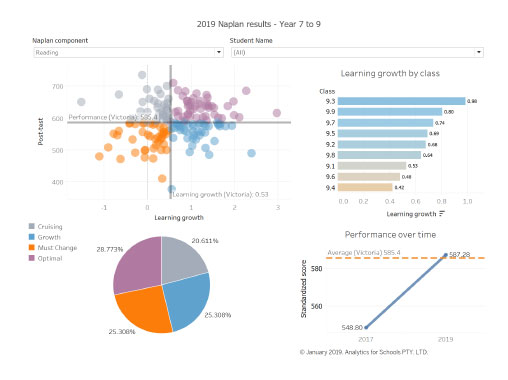Are your students learning enough?
Fast and reliable, the Learning Growth Estimator analyses the results from standardized tests to evaluate student learning and progress at both individual and school level. It enables schools to review the effectiveness of their educational interventions and to develop future action plans. Functioning across a range of learning components, it facilitates comparisons with State, Territory, and national values while also providing other insights into student and school performance.

How does it work?
The Learning Growth Estimator performs statistical calculations, on behalf of the user, to generate a range of user-friendly reports from the raw data provided. Using data visualization, it enables principals and teachers to quickly access the results and assess the effectiveness of their interventions that, in turn, informs their future actions.

This tool is not only easy to use, but it also has excellent graphics that help tell the story about impact.
Professor The University of Melbourne
Frequently Asked Questions
What is learning growth, and how is it estimated?
‘Learning growth’ is the amount of academic progress a student achieves over a period of time, usually a year. We measure learning growth by estimating ‘effect sizes’. The effect size, in turn, is a quantitative measure of the strength or impact of an intervention or phenomenon. Recent research evidence suggests that schools should focus on effect sizes as opposed to test scores; that is, the focus should be on the amount of learning achieved by students rather than in their results. Therefore, it is vital that schools estimate learning growth so they can measure the impact of educational interventions on their students. Analytics for Schools estimate effect sizes on behalf of schools using data from different standardized tests including Naplan, OnDemand, PAT testing, and Allwell, then make the results available to teachers so they can evaluate the success of their interventions and plan accordingly.
What is the expected learning growth over one year of intervention?
According to the literature, we should expect larger effect sizes in younger populations compared to adults. Expected effect sizes for a period of one year are as follows:
- Children from year 3 to year 5 = 0.59
- Children from year 5 to year 7 = 0.35
- Young adolescents from year 7 to year 9 = 0.26
How secure is my data?
All our services are tools are delivered in compliance with the Australian Privacy Principles, and all details concerning the collection, use, and security of your data is clearly presented to you in our service agreement and privacy policy.
Does my school get support in case of technical issues with any of the learning analytics services?
Yes. If you have any issues with our services, please contact us on 0415821524 or by email info@analyticsforschools.com.au
